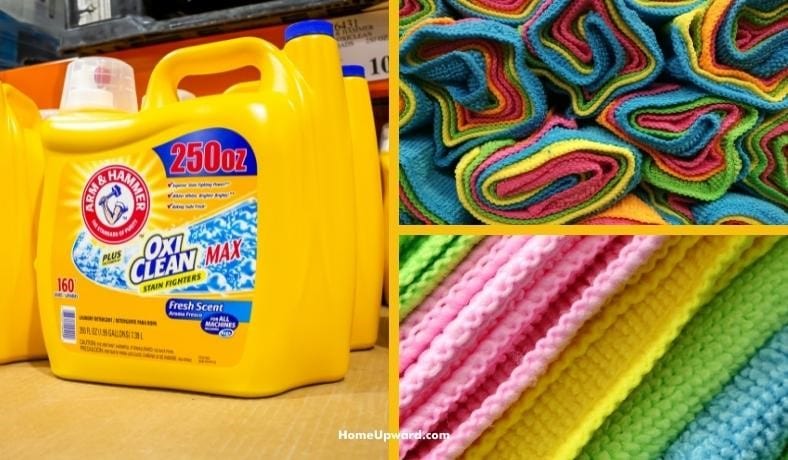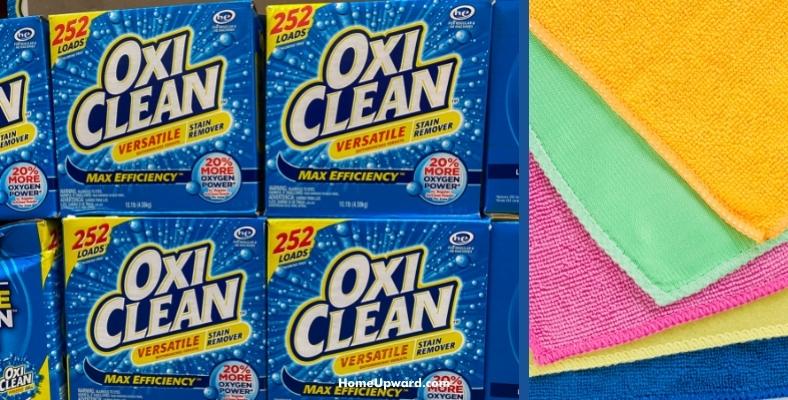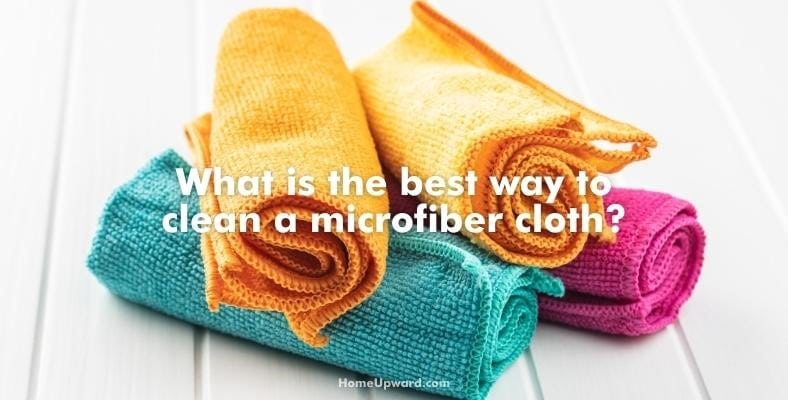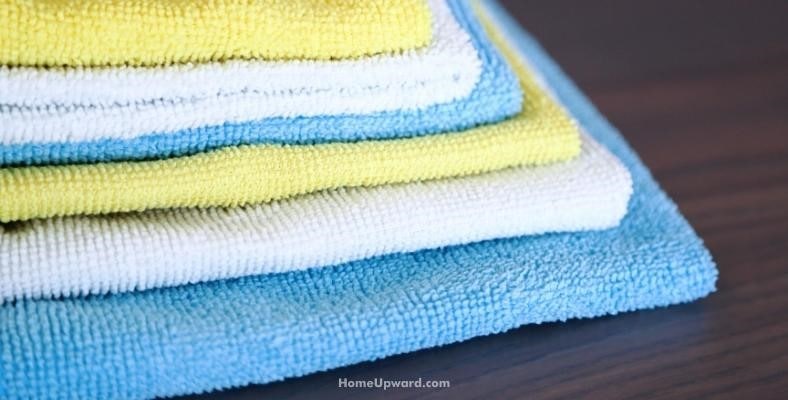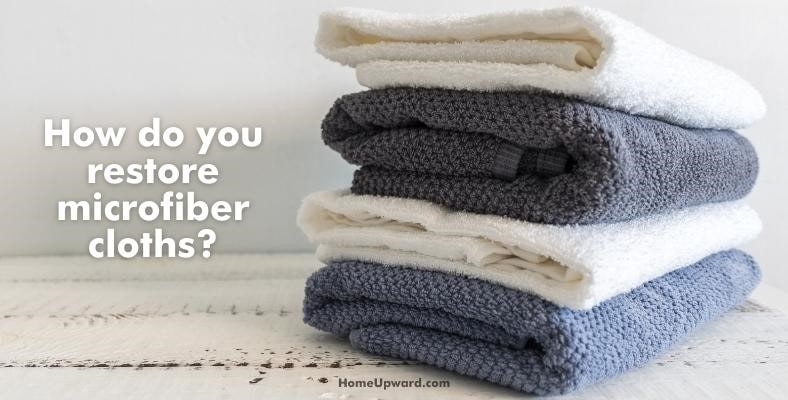Contents
Can You Use OxiClean on Microfiber Cloths?
Yes, you can use OxiClean on a microfiber cloth and it’s a good cleaner for them.
Before washing your laundry, let them soak for a few hours in a gallon of warm water and a cup of OxiClean. That’ll helps to remove surface stains and underlying residue.
A great reason to use it instead of other cleaning products is that OxiClean lacks the harsh chemicals and fragrances of other detergents which can harm your cloth towels in some cases.
What Is the Best Way To Clean a Microfiber Cloth?
Avoid using the following things for cleaning microfiber cloth:
- No bleach
- No heat
- No fabric conditioners!
Unlike OxiClean, bleach causes damage to the individual loops on a microfiber cloth. The same goes for other high alkaline cleaning products like all-purpose cleaners.
Heat is also a terrible choice and one of microfiber’s biggest enemies when it comes to washing. Too high of a temperature not only melts the cloth itself but also rounds down the fibers’ hooks, meaning the microfiber fabric cleaning ability is ruined.
Using fabric softeners results in the same problem. Fabric softeners almost always impact the fabric’s ability to conduct static electricity which is an important part of how microfiber material gathers dirt and grime on surfaces so easily.
Ways to clean a microfiber cloth
1. Using detergent and soaking
Instead of attempting to clean a microfiber cloth one of those ways, try this instead:
- First, shake the excess dirt and dust from the microfiber cleaning cloth. This eases the task of towel washing overall.
- The next step depends on personal preferences: if there’s a huge stain on the cloth, spot treat it, or, if it doesn’t bother you, move on to the next step.
- Allow the towels to soak in a combination of warm water and laundry detergent. It’s important to use a mild detergent with no fragrances, additives, or similar ingredients since the chemicals negatively affect the microfiber itself. Let the cloths soak for at least 15 minutes but no longer than overnight.
2. Using OxiClean or vinegar
If you want an even cleaner result you can add a scoop of OxiClean or a cup of distilled white vinegar to the water/detergent mix.
- While the towels soak, take a moment to ensure the lint trap in your dryer is empty. Also, check that no extra lint remains in the drum. Not checking can result in the lint lodging in the microfiber’s microscopic hooks.
- Now that the cloths have soaked, you should rinse them under cold water and rub them to help remove any leftover particles. Once you’ve finished, place the towels in the washing machine – never overload the machine – and choose the lowest heat setting. Let the cycle run its course.
- When it’s time to dry the towels the best way is to air dry the cleaning cloths. However, if you need them sooner or don’t have the space using a clothes dryer works just fine too. Again, select the lowest heating. If possible, select the no heat and/or air fluff option to simulate air drying. Avoid using dryer sheets.
In the end, your towels should be clean, fresh, and ready for another adventure.
What Detergents Are Safe for Microfiber?
- Cleaning microfiber fabric is best done with detergents that are free of harsh chemicals and/or odors. Make sure the one you want to use doesn’t have additives or dyes in it since this can also impede the washing process.
- Avoid using 2-in-1 detergents as they contain fabric softener.
- In addition to laundry detergent, some companies produce detergents specifically for cleaning microfiber cloths. Pinnacle Micro Rejuvenator, for instance, manages to remove all remnants of debris while simultaneously softening the fabric.
These types of detergents work more efficiently than your average laundry detergent but might not be affordable or easily accessible. For that reason, combining water, detergent, and vinegar can be just as effective with the drawback being it’s slower.
Can You Wash Microfiber Towels With Dawn Dish Soap?
No, microfiber towels should not be washed with Dawn dish soap. Even scent-free dish soaps like dish detergents may include substances that cause more harm than good to your microfiber towels.
How Often Should You Wash Microfiber Cloths?
You should wash them when they become dirty. Leaving dirt and other residues to sit and dry impacts the microfibers’ ability to clean properly.
When cleaning another item with the same cloth, streaks can happen which you really don’t want. If you’re only using your microfiber cloths every once it a while I’d recommend washing them every few months.
How Do You Restore Microfiber Cloths?
Although you won’t be able to completely restore a worn out microfiber cloth, you can clean it to the best of your ability to revive some of its power. Do the same as you would for washing but this time add a second soak/wash.
To restoring microfiber cloths:
- Your first should be some combination of water and detergent or water, detergent, and white vinegar, but, if that isn’t enough, follow it up with 1 cup (0.24 l) of ammonia combined with ½ cup of detergent.
- Allow it to soak before cleaning it in the washing machine.
- Repeat the wash process again.
Can White Vinegar Damage Microfiber?
Distilled white vinegar doesn’t damage microfiber materials. In fact it’s helpful to the material.
Using a cup of distilled white vinegar helps to dissolve and remove the remaining residue while also keeping the microfibers fresh. Vinegar is a good, gentle way to soften the cloth.

